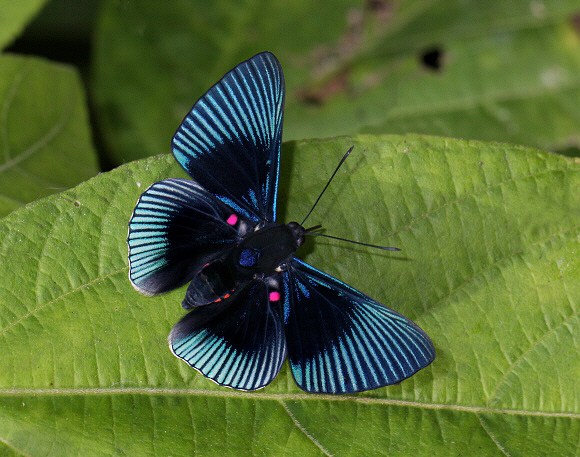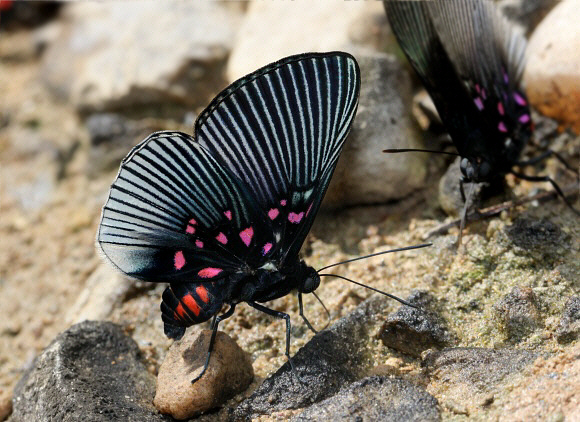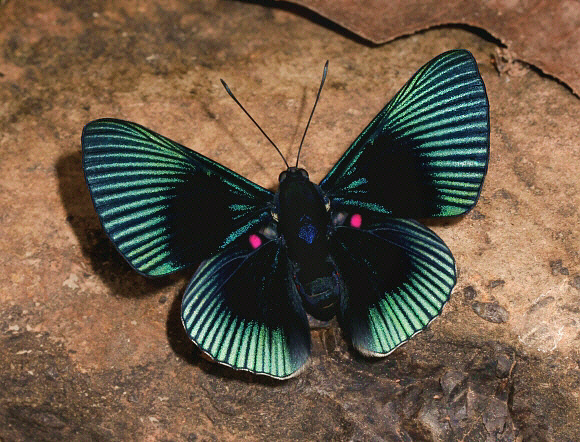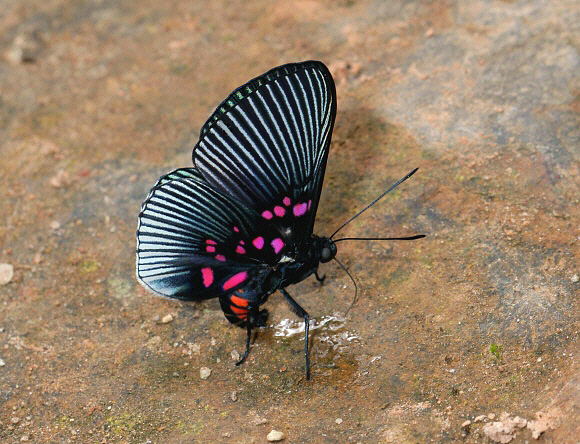 Lyropteryx apollonia, male, Rio Shima, Peru – Adrian Hoskins
Lyropteryx apollonia, male, Rio Shima, Peru – Adrian Hoskins
Introduction
The genus Lyropteryx comprises of 4 known species. They are among the largest of the Riodinids, with a wingspan of circa 50mm.
The males of all the species are black on the upperside, marked on the outer half of the wings with radiating turquoise lines. They bear a strong resemblance to Arctiid moths in the genus Hypocrita. Both Lyropteryx and Hypocrita are rejected by birds so are probably noxious Mullerian mimics. In females of Lyropteryx the outer rays on the wings are white, and the hindwings have a broad red marginal band similar to that of Biblis hyperia – another noxious species. In all Lyropteryx species the underside is black with radiating white lines and numerous large red spots in the basal area.
Butterflies in the closely allied genus Necyria are generally similar but the upperside markings tend to form into wide bands. Also the red spots on the underside are larger and fewer in number, and the wings more angular.
Lyropteryx apollonia is widely distributed throughout the tropical regions of South America including Colombia, western and southern Brazil, Peru, and Bolivia.
 Lyropteryx apollonia, Satipo, Peru – Adrian Hoskins
Lyropteryx apollonia, Satipo, Peru – Adrian Hoskins
Habitats
This species is found in rainforest and cloudforest habitats at altitudes between about 200-1000m. The butterflies are usually found solitarily in the vicinity of streams or rivers. They can be found throughout the year but are encountered more commonly in the dry season.
Lifecycle
The larvae feed on Vochysia ( Vochysiaceae ).
 Lyropteryx apollonia, Rio Shima, Peru – Adrian Hoskins
Lyropteryx apollonia, Rio Shima, Peru – Adrian Hoskins
Adult behaviour
Males are occasionally seen visiting sewage seepages or urine-soaked ground. They drink using the “filter-feeding” method, whereby they imbibe almost continually, extracting salts from mineral-rich patches of ground, or from the edges of puddles. Periodically they squirt the demineralised water from their anus, curving their abdomen so as to aim the liquid at the ground beneath their feet. There it leaches more minerals from the ground, which are re-imbibed. This process is continuous and the butterflies often recycle the same fluid many times during a period of several minutes.
They remain settled for long periods, often hiding in gaps between rocks, are not easily disturbed. The wings are normally held in the V-position, or slowly fanned, but a butterfly which has been on the ground for a long period will sometimes bask with wings fully outspread.
Females do not visit mineral sources. It is likely that they visit Eupatorium flowers for nectar, as I have observed this behaviour often with females of the closely related genus Necyria.

Lyropteryx apollonia, male filter-feeding, Rio Shima, Peru – Adrian Hoskins
